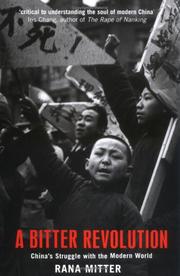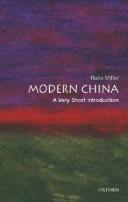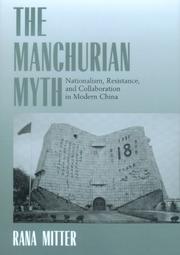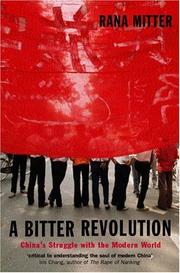| Listing 1 - 10 of 22 | << page >> |
Sort by
|

ISBN: 0192803417 Year: 2004 Volume: *1 Publisher: Oxford New York Tokyo Oxford University Press
Abstract | Keywords | Export | Availability | Bookmark
 Loading...
Loading...Choose an application
- Reference Manager
- EndNote
- RefWorks (Direct export to RefWorks)
China --- History --- Politics and government --- 20th century
Book
ISBN: 9780544334502 9780618894253 Year: 2014 Publisher: Boston Mariner Books
Abstract | Keywords | Export | Availability | Bookmark
 Loading...
Loading...Choose an application
- Reference Manager
- EndNote
- RefWorks (Direct export to RefWorks)
"For decades, a major piece of World War II history has gone virtually unwritten. China was the fourth great ally, partner to the United States, the Soviet Union, and Great Britain, yet its drama of invasion, resistance, slaughter, and political intrigue remains little known in the West. In this emotionally gripping book, made possible through access to newly unsealed Chinese archives, Rana Mitter unfurls the story of China's World War II as never before and rewrites the larger history of the war in the process. He focuses his narrative on three towering leaders -- Chiang Kai-shek, Mao Zedong, and the lesser-known collaborator Wang Jingwei -- and extends the timeline of the war back to 1937, when Japanese and Chinese troops began to clash, fully two years before Hitler invaded Poland. Unparalleled in its research and scope, Forgotten Ally is a sweeping, character-driven history that will be essential reading not only for anyone with an interest in World War II, but also for those seeking to understand today's China, where, as Mitter reveals, the echoes of the war still reverberate"--
Sino-Japanese War, 1937-1945. --- World War, 1939-1945 --- S04/0825 --- J3386 --- Chinese-Japanese War, 1937-1945 --- Japan-China War, 1937-1945 --- Japanese-Chinese War, 1937-1945 --- Second Sino-Japanese War, 1937-1945 --- Sino-Japanese Conflict, 1937-1945 --- China: History--War against Japan: 1931/1937 - 1945 --- Japan: History -- Gendai, modern -- Shōwa period -- World War II -- war with China (1937-1945) --- Sino-Japanese War (1937-1945) --- World War (1939-1945) --- China --- History --- Sino-Japanese War, 1937-1945

ISBN: 1280752351 0191513008 142946870X 9780191513008 9780192803412 0192803417 9781280752353 9786610752355 6610752354 9781429468701 Year: 2004 Publisher: Oxford ; New York : Oxford University Press,
Abstract | Keywords | Export | Availability | Bookmark
 Loading...
Loading...Choose an application
- Reference Manager
- EndNote
- RefWorks (Direct export to RefWorks)
China is now poised to take a key role on the world stage, but in the early twentieth century the situation could not have been more different. Rana Mitter goes back to this pivotal moment in Chinese history to uncover the origins of the painful transition from a premodern past into a modern world. Mitter takes us through the resulting social turmoil and political promise, the devastating war against Japan in the 1940s, Communism and the Cultural Revolution of the 1960s, and the new era of hope in the 1980s ended by the Tian'anmen uprising. He reveals the impetus behind the dramatic changes in
China --- History --- Politics and government

ISBN: 1281341231 9786611341237 019152784X 9780191527845 9780191068188 0191068187 9780199228027 0199228027 Year: 2008 Publisher: Oxford ; New York : Oxford University Press,
Abstract | Keywords | Export | Availability | Bookmark
 Loading...
Loading...Choose an application
- Reference Manager
- EndNote
- RefWorks (Direct export to RefWorks)
China today is never out of the news: from human rights controversies and the continued legacy of Tiananmen Square, to global coverage of the Beijing Olympics, and the Chinese 'economic miracle'. This Very Short Introduction provides an accessible guide to why China looks the way it does today, and how it got there. - ;China today is never out of the news: from human rights controversies and the continued legacy of Tiananmen Square, to global coverage of the Beijing Olympics, and the Chinese 'economic miracle'. It seems a country of contradictions: a peasant society with some of the world's mo
China --- Cina --- Kinë --- Cathay --- Chinese National Government --- Chung-kuo kuo min cheng fu --- Republic of China (1912-1949) --- Kuo min cheng fu (China : 1912-1949) --- Chung-hua min kuo (1912-1949) --- Kina (China) --- National Government (1912-1949) --- China (Republic : 1912-1949) --- People's Republic of China --- Chinese People's Republic --- Chung-hua jen min kung ho kuo --- Central People's Government of Communist China --- Chung yang jen min cheng fu --- Chung-hua chung yang jen min kung ho kuo --- Central Government of the People's Republic of China --- Zhonghua Renmin Gongheguo --- Zhong hua ren min gong he guo --- Kitaĭskai︠a︡ Narodnai︠a︡ Respublika --- Činská lidová republika --- RRT --- Republik Rakjat Tiongkok --- KNR --- Kytaĭsʹka Narodna Respublika --- Jumhūriyat al-Ṣīn al-Shaʻbīyah --- RRC --- Kitaĭ --- Kínai Népköztársaság --- Chūka Jinmin Kyōwakoku --- Erets Sin --- Sin --- Sāthāranarat Prachāchon Čhīn --- P.R. China --- PR China --- Chung-kuo --- Zhongguo --- Zhonghuaminguo (1912-1949) --- Zhong guo --- Chine --- République Populaire de Chine --- República Popular China --- Catay --- VR China --- VRChina --- 中國 --- 中国 --- 中华人民共和国 --- Jhongguó --- Bu̇gu̇de Nayiramdaxu Dundadu Arad Ulus --- Bu̇gu̇de Nayiramdaqu Dumdadu Arad Ulus --- Bu̇gd Naĭramdakh Dundad Ard Uls --- Khi︠a︡tad --- Kitad --- Dumdadu Ulus --- Dumdad Uls --- Думдад Улс --- Kitajska --- China (Republic : 1949- ) --- Civilization --- Western influences. --- Occidental influences --- #SBIB:328H52 --- #SBIB:39A75 --- Instellingen en beleid: China --- Etnografie: Azië --- PRC --- P.R.C. --- BNKhAU --- БНХАУ

ISBN: 052092388X 1597347329 9780520923881 9780585391243 0585391246 9781597347327 9780520221116 0520221117 Year: 2000 Publisher: Berkeley : University of California Press,
Abstract | Keywords | Export | Availability | Bookmark
 Loading...
Loading...Choose an application
- Reference Manager
- EndNote
- RefWorks (Direct export to RefWorks)
A powerful element in twentieth-century Chinese politics has been the myth of Chinese resistance to Japan's seizure of Manchuria in 1931. Investigating the shifting alliances of key players in that event, Rana Mitter traces the development of the narrative of resistance to the occupation and shows how it became part of China's political consciousness, enduring even today. After Japan's September 1931 military strike leading to a takeover of the Northeast, the Chinese responded in three major ways: collaboration, resistance in exile, and resistance on the ground. What motives prompted some Chinese to collaborate, others to resist? What were conditions like under the Japanese? Through careful reading of Chinese and Japanese sources, particularly local government records, newspapers, and journals published both inside and outside occupied Manchuria, Mitter sheds important new light on these questions.
Nationalism --- Consciousness, National --- Identity, National --- National consciousness --- National identity --- International relations --- Patriotism --- Political science --- Autonomy and independence movements --- Internationalism --- Political messianism --- Manchuria (China) --- History --- 1930s. --- china. --- chinese history. --- chinese nationalism. --- collaborators. --- colonialism. --- exile. --- government. --- history. --- imperialism. --- japan. --- japanese occupation. --- kwantung army. --- league of nations. --- ma zhanshan. --- manchukuo. --- manchuria. --- may thirtieth incident. --- military. --- nanjing. --- nation. --- nationalism. --- nonfiction. --- occupied zone. --- political history. --- politics. --- postwar. --- puppet government. --- rebellion. --- resistance fighters. --- resistance. --- salvation society. --- tanggu truce. --- versailles conference. --- violence. --- war. --- zhang xueliang.

ISBN: 9780192806055 Year: 2010 Publisher: Oxford Oxford University Press
Abstract | Keywords | Export | Availability | Bookmark
 Loading...
Loading...Choose an application
- Reference Manager
- EndNote
- RefWorks (Direct export to RefWorks)
Book
ISBN: 9780141031453 Year: 2014 Publisher: London Penguin Books
Abstract | Keywords | Export | Availability | Bookmark
 Loading...
Loading...Choose an application
- Reference Manager
- EndNote
- RefWorks (Direct export to RefWorks)
Different countries give different opening dates for the period of the Second World War, but perhaps the most compelling is 1937, when the 'Marco Polo Bridge Incident' plunged China and Japan into a conflict of extraordinary duration and ferocity - a war which would result in many millions of deaths and completely reshape East Asia in ways which we continue to confront today. With great vividness and narrative drive Rana Mitter's book draws on a huge range of new sources to recreate this terrible conflict. He writes both about the major leaders (Chiang Kaishek, Mao Zedong and Wang Jingwei) and about the ordinary people swept up by terrible times. Mitter puts at the heart of our understanding of the Second World War that it was Japan's failure to defeat China which was the key dynamic for what happened in Asia.
Sino-Japanese War, 1937-1945 --- World War, 1939-1945 --- Sino-Japanese War (1937-1945) --- World War (1939-1945) --- China --- Japan --- History --- Foreign relations
Book
ISBN: 9780674984264 0674984269 Year: 2020 Publisher: Cambridge Belknap Press of Harvard University Press
Abstract | Keywords | Export | Availability | Bookmark
 Loading...
Loading...Choose an application
- Reference Manager
- EndNote
- RefWorks (Direct export to RefWorks)
"Once sidelined from public memory, World War II is now a historical touchstone in China. Rana Mitter links the reassessment of the war to China's rising nationalism. At home, Chinese use the war to shape conflicted identities; abroad the war with Japan is now treated as a Chinese victory, a founding myth for a people destined to shape the global order"--
Nationalism and collective memory --- Sino-Japanese War, 1937-1945 --- Chinese --- Public opinion --- Attitudes --- China --- Historiography. --- Civilization

ISBN: 019280605X Year: 2005 Publisher: Oxford Oxford university press
Abstract | Keywords | Export | Availability | Bookmark
 Loading...
Loading...Choose an application
- Reference Manager
- EndNote
- RefWorks (Direct export to RefWorks)
Book
ISBN: 9780198753704 0198753705 Year: 2016 Publisher: Oxford Oxford University Press
Abstract | Keywords | Export | Availability | Bookmark
 Loading...
Loading...Choose an application
- Reference Manager
- EndNote
- RefWorks (Direct export to RefWorks)
"China today is never out of the news, with stories about international finance, population, and human rights controversies. From the contrast between its ancient heritage and emerging identity to the Chinese 'economic miracle', this Very Short Introduction addresses the themes, developments, and contradictions that have shaped Modern China. In this new edition Rana Mitter provides a contemporary view of the world's most populous nation, considering China's changing foreign policy, and its unique engagement with the internet. Giving an integrated picture of modern Chinese society, Mitter also addresses China's current global position, and analyses the country's growth in international significance"--Front flap.
China --- Civilization --- History --- Social life and customs --- Politics and government --- Economic conditions --- Sociology of culture --- Politics --- Economics --- Law
| Listing 1 - 10 of 22 | << page >> |
Sort by
|

 Search
Search Feedback
Feedback About UniCat
About UniCat  Help
Help News
News